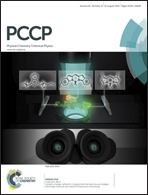Energy transfer in aggregates of bacteriochlorophyll c self-assembled with azulene derivatives†
Abstract
Bacteriochlorophyll (BChl) c is the main light-harvesting pigment of certain photosynthetic bacteria. It is found in the form of self-assembled aggregates in the so-called chlorosomes. Here we report the results of co-aggregation experiments of BChl c with azulene and its tailored derivatives. We have performed spectroscopic and quantum chemical characterization of the azulenes, followed by self-assembly experiments. The results show that only azulenes with sufficient hydrophobicity are able to induce aggregation of BChl c. Interestingly, only azulene derivatives possessing a conjugated phenyl ring were capable of efficient (∼50%) excitation energy transfer to BChl molecules. These aggregates represent an artificial light-harvesting complex with enhanced absorption between 220 and 350 nm compared to aggregates of pure BChl c. The results provide insight into the principles of self-assembly of BChl aggregates and suggest an important role of the π–π interactions in efficient energy transfer.


 Please wait while we load your content...
Please wait while we load your content...